The Effectiveness of Relaxation Breathing in Reducing Anxiety
VerifiedAdded on 2022/09/13
|6
|976
|51
Essay
AI Summary
This essay explores relaxation breathing as a technique to reduce anxiety. It begins by defining anxiety disorders and their symptoms, including panic attacks, and highlights the importance of managing anxiety for overall well-being. The essay then delves into the elements of relaxation breathin...
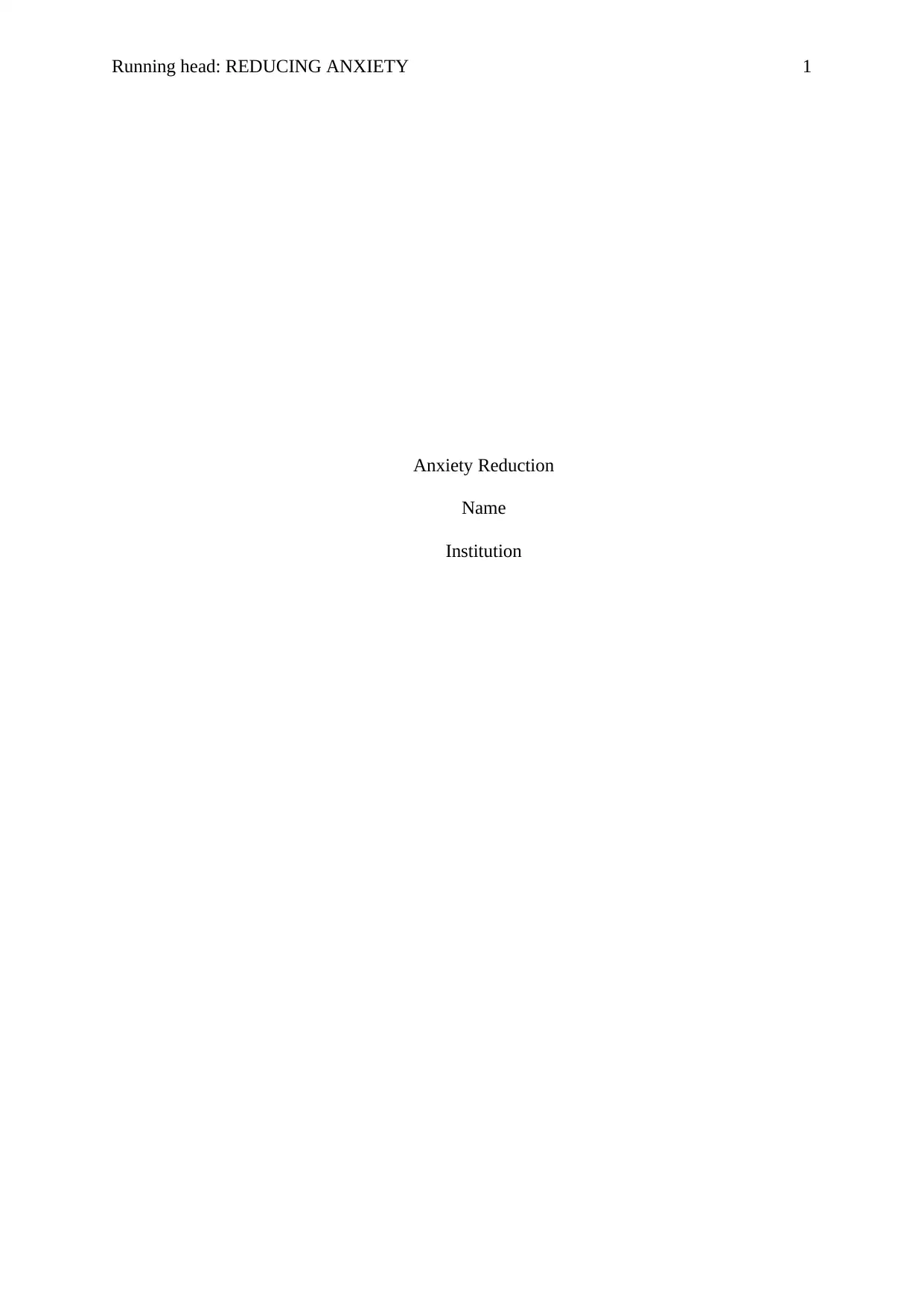
Running head: REDUCING ANXIETY 1
Anxiety Reduction
Name
Institution
Anxiety Reduction
Name
Institution
Secure Best Marks with AI Grader
Need help grading? Try our AI Grader for instant feedback on your assignments.
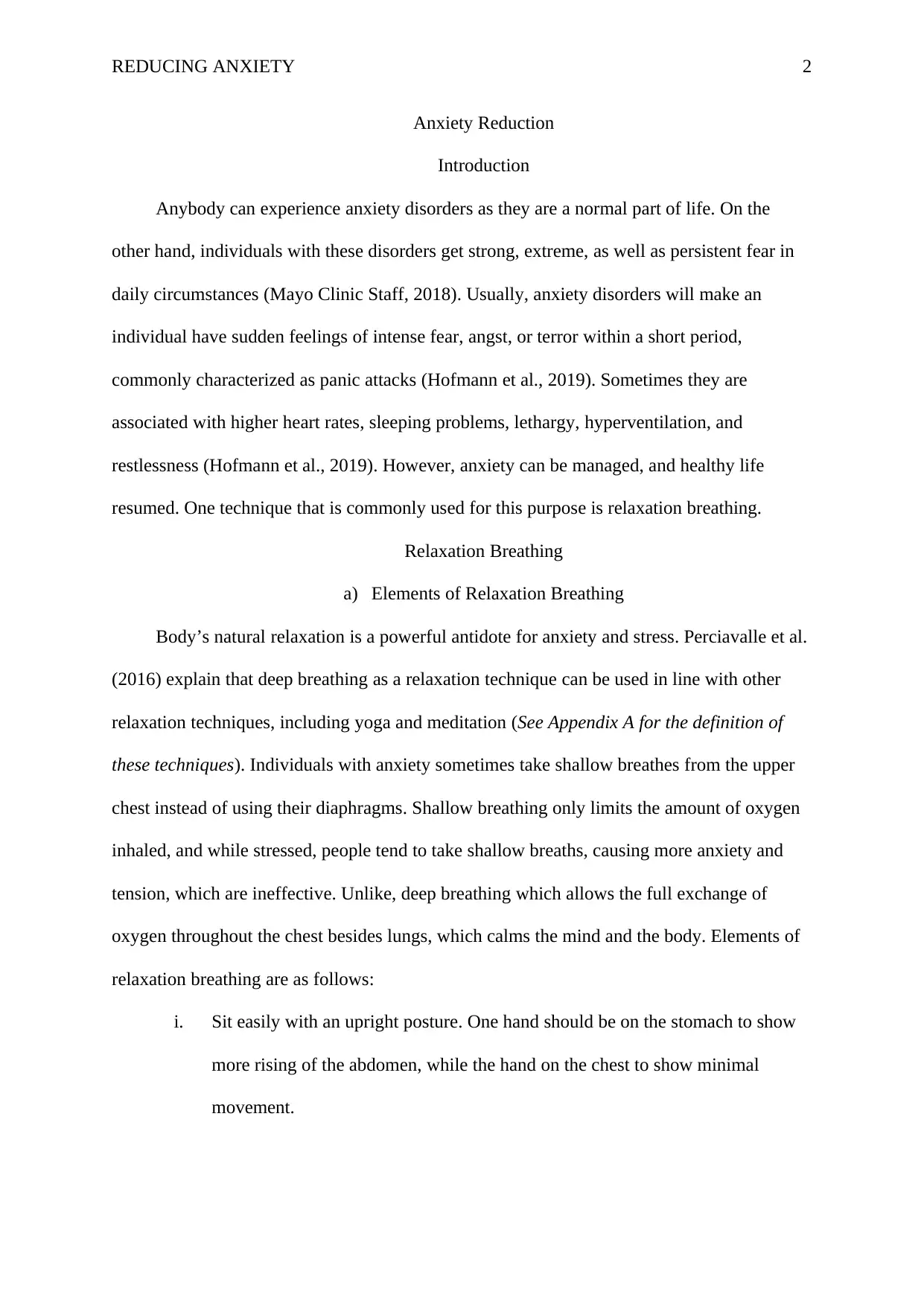
REDUCING ANXIETY 2
Anxiety Reduction
Introduction
Anybody can experience anxiety disorders as they are a normal part of life. On the
other hand, individuals with these disorders get strong, extreme, as well as persistent fear in
daily circumstances (Mayo Clinic Staff, 2018). Usually, anxiety disorders will make an
individual have sudden feelings of intense fear, angst, or terror within a short period,
commonly characterized as panic attacks (Hofmann et al., 2019). Sometimes they are
associated with higher heart rates, sleeping problems, lethargy, hyperventilation, and
restlessness (Hofmann et al., 2019). However, anxiety can be managed, and healthy life
resumed. One technique that is commonly used for this purpose is relaxation breathing.
Relaxation Breathing
a) Elements of Relaxation Breathing
Body’s natural relaxation is a powerful antidote for anxiety and stress. Perciavalle et al.
(2016) explain that deep breathing as a relaxation technique can be used in line with other
relaxation techniques, including yoga and meditation (See Appendix A for the definition of
these techniques). Individuals with anxiety sometimes take shallow breathes from the upper
chest instead of using their diaphragms. Shallow breathing only limits the amount of oxygen
inhaled, and while stressed, people tend to take shallow breaths, causing more anxiety and
tension, which are ineffective. Unlike, deep breathing which allows the full exchange of
oxygen throughout the chest besides lungs, which calms the mind and the body. Elements of
relaxation breathing are as follows:
i. Sit easily with an upright posture. One hand should be on the stomach to show
more rising of the abdomen, while the hand on the chest to show minimal
movement.
Anxiety Reduction
Introduction
Anybody can experience anxiety disorders as they are a normal part of life. On the
other hand, individuals with these disorders get strong, extreme, as well as persistent fear in
daily circumstances (Mayo Clinic Staff, 2018). Usually, anxiety disorders will make an
individual have sudden feelings of intense fear, angst, or terror within a short period,
commonly characterized as panic attacks (Hofmann et al., 2019). Sometimes they are
associated with higher heart rates, sleeping problems, lethargy, hyperventilation, and
restlessness (Hofmann et al., 2019). However, anxiety can be managed, and healthy life
resumed. One technique that is commonly used for this purpose is relaxation breathing.
Relaxation Breathing
a) Elements of Relaxation Breathing
Body’s natural relaxation is a powerful antidote for anxiety and stress. Perciavalle et al.
(2016) explain that deep breathing as a relaxation technique can be used in line with other
relaxation techniques, including yoga and meditation (See Appendix A for the definition of
these techniques). Individuals with anxiety sometimes take shallow breathes from the upper
chest instead of using their diaphragms. Shallow breathing only limits the amount of oxygen
inhaled, and while stressed, people tend to take shallow breaths, causing more anxiety and
tension, which are ineffective. Unlike, deep breathing which allows the full exchange of
oxygen throughout the chest besides lungs, which calms the mind and the body. Elements of
relaxation breathing are as follows:
i. Sit easily with an upright posture. One hand should be on the stomach to show
more rising of the abdomen, while the hand on the chest to show minimal
movement.
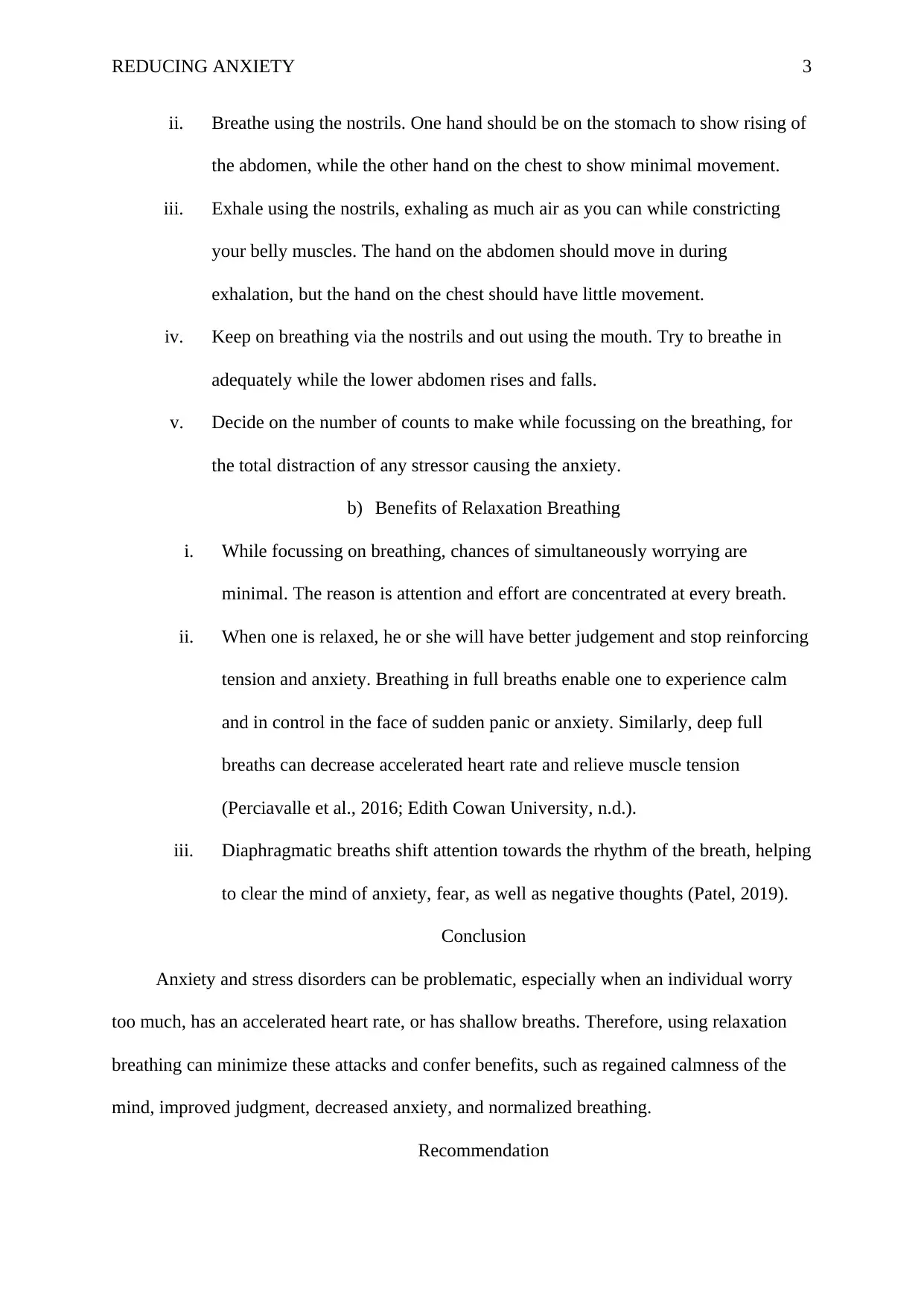
REDUCING ANXIETY 3
ii. Breathe using the nostrils. One hand should be on the stomach to show rising of
the abdomen, while the other hand on the chest to show minimal movement.
iii. Exhale using the nostrils, exhaling as much air as you can while constricting
your belly muscles. The hand on the abdomen should move in during
exhalation, but the hand on the chest should have little movement.
iv. Keep on breathing via the nostrils and out using the mouth. Try to breathe in
adequately while the lower abdomen rises and falls.
v. Decide on the number of counts to make while focussing on the breathing, for
the total distraction of any stressor causing the anxiety.
b) Benefits of Relaxation Breathing
i. While focussing on breathing, chances of simultaneously worrying are
minimal. The reason is attention and effort are concentrated at every breath.
ii. When one is relaxed, he or she will have better judgement and stop reinforcing
tension and anxiety. Breathing in full breaths enable one to experience calm
and in control in the face of sudden panic or anxiety. Similarly, deep full
breaths can decrease accelerated heart rate and relieve muscle tension
(Perciavalle et al., 2016; Edith Cowan University, n.d.).
iii. Diaphragmatic breaths shift attention towards the rhythm of the breath, helping
to clear the mind of anxiety, fear, as well as negative thoughts (Patel, 2019).
Conclusion
Anxiety and stress disorders can be problematic, especially when an individual worry
too much, has an accelerated heart rate, or has shallow breaths. Therefore, using relaxation
breathing can minimize these attacks and confer benefits, such as regained calmness of the
mind, improved judgment, decreased anxiety, and normalized breathing.
Recommendation
ii. Breathe using the nostrils. One hand should be on the stomach to show rising of
the abdomen, while the other hand on the chest to show minimal movement.
iii. Exhale using the nostrils, exhaling as much air as you can while constricting
your belly muscles. The hand on the abdomen should move in during
exhalation, but the hand on the chest should have little movement.
iv. Keep on breathing via the nostrils and out using the mouth. Try to breathe in
adequately while the lower abdomen rises and falls.
v. Decide on the number of counts to make while focussing on the breathing, for
the total distraction of any stressor causing the anxiety.
b) Benefits of Relaxation Breathing
i. While focussing on breathing, chances of simultaneously worrying are
minimal. The reason is attention and effort are concentrated at every breath.
ii. When one is relaxed, he or she will have better judgement and stop reinforcing
tension and anxiety. Breathing in full breaths enable one to experience calm
and in control in the face of sudden panic or anxiety. Similarly, deep full
breaths can decrease accelerated heart rate and relieve muscle tension
(Perciavalle et al., 2016; Edith Cowan University, n.d.).
iii. Diaphragmatic breaths shift attention towards the rhythm of the breath, helping
to clear the mind of anxiety, fear, as well as negative thoughts (Patel, 2019).
Conclusion
Anxiety and stress disorders can be problematic, especially when an individual worry
too much, has an accelerated heart rate, or has shallow breaths. Therefore, using relaxation
breathing can minimize these attacks and confer benefits, such as regained calmness of the
mind, improved judgment, decreased anxiety, and normalized breathing.
Recommendation
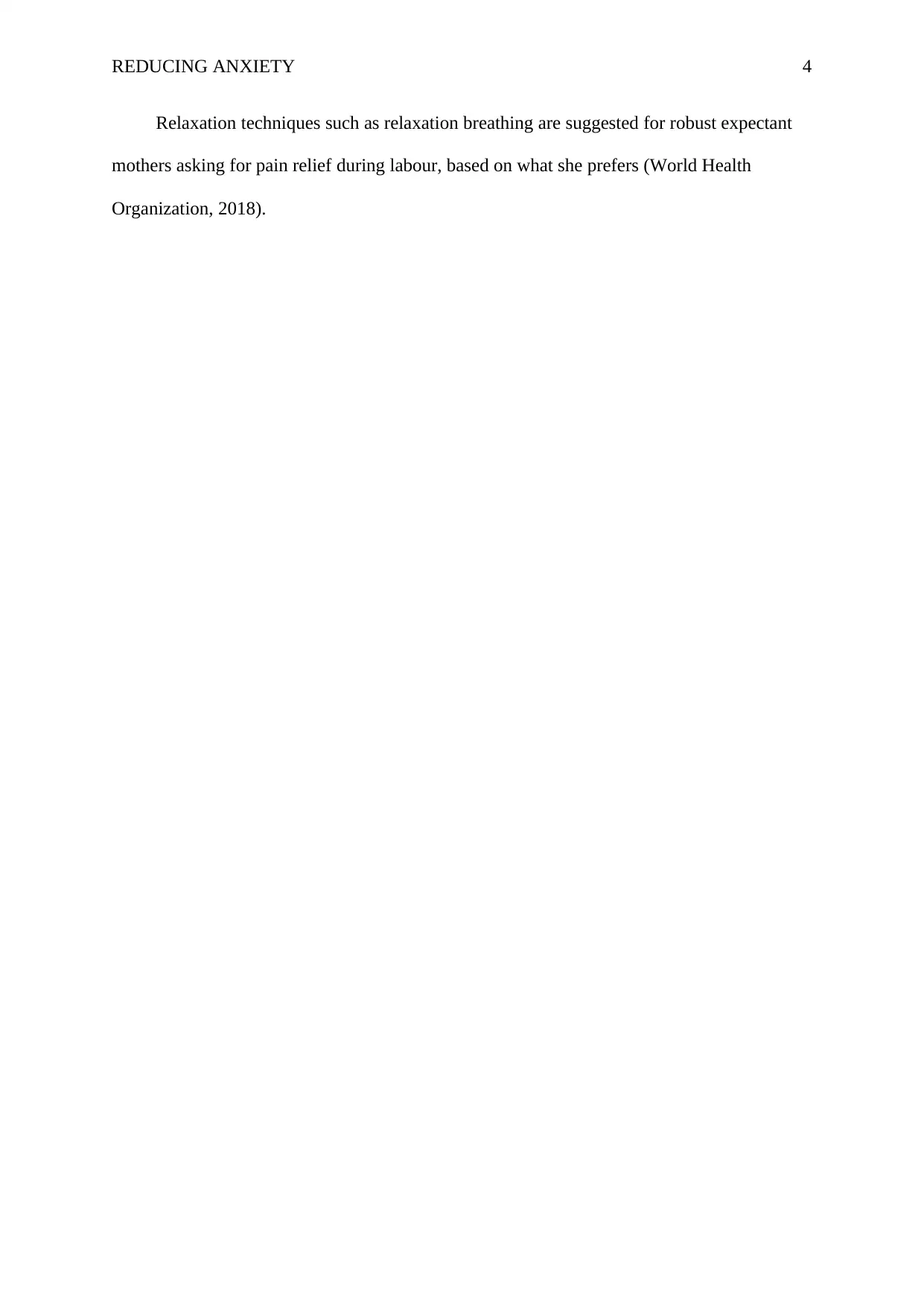
REDUCING ANXIETY 4
Relaxation techniques such as relaxation breathing are suggested for robust expectant
mothers asking for pain relief during labour, based on what she prefers (World Health
Organization, 2018).
Relaxation techniques such as relaxation breathing are suggested for robust expectant
mothers asking for pain relief during labour, based on what she prefers (World Health
Organization, 2018).
Secure Best Marks with AI Grader
Need help grading? Try our AI Grader for instant feedback on your assignments.
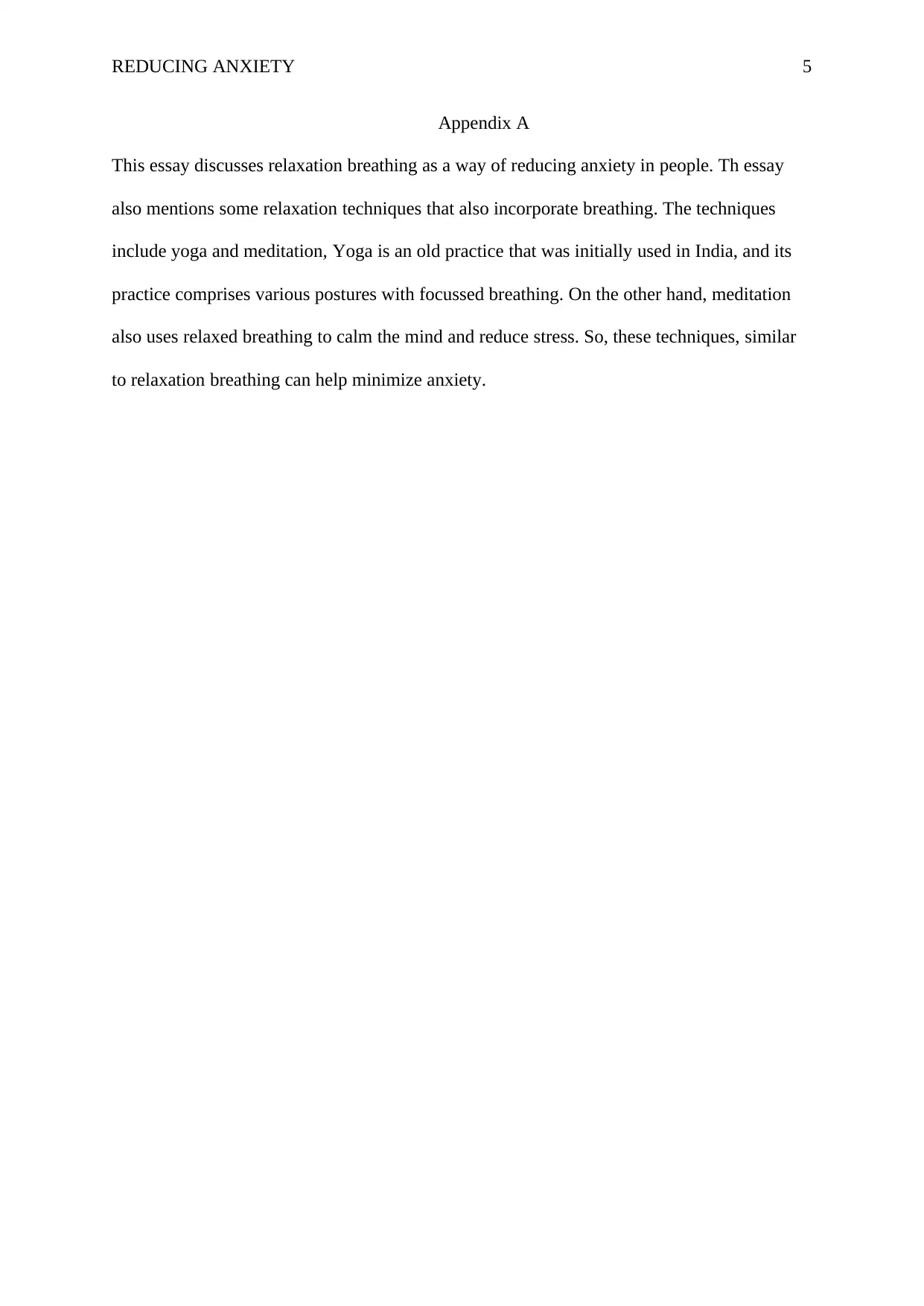
REDUCING ANXIETY 5
Appendix A
This essay discusses relaxation breathing as a way of reducing anxiety in people. Th essay
also mentions some relaxation techniques that also incorporate breathing. The techniques
include yoga and meditation, Yoga is an old practice that was initially used in India, and its
practice comprises various postures with focussed breathing. On the other hand, meditation
also uses relaxed breathing to calm the mind and reduce stress. So, these techniques, similar
to relaxation breathing can help minimize anxiety.
Appendix A
This essay discusses relaxation breathing as a way of reducing anxiety in people. Th essay
also mentions some relaxation techniques that also incorporate breathing. The techniques
include yoga and meditation, Yoga is an old practice that was initially used in India, and its
practice comprises various postures with focussed breathing. On the other hand, meditation
also uses relaxed breathing to calm the mind and reduce stress. So, these techniques, similar
to relaxation breathing can help minimize anxiety.
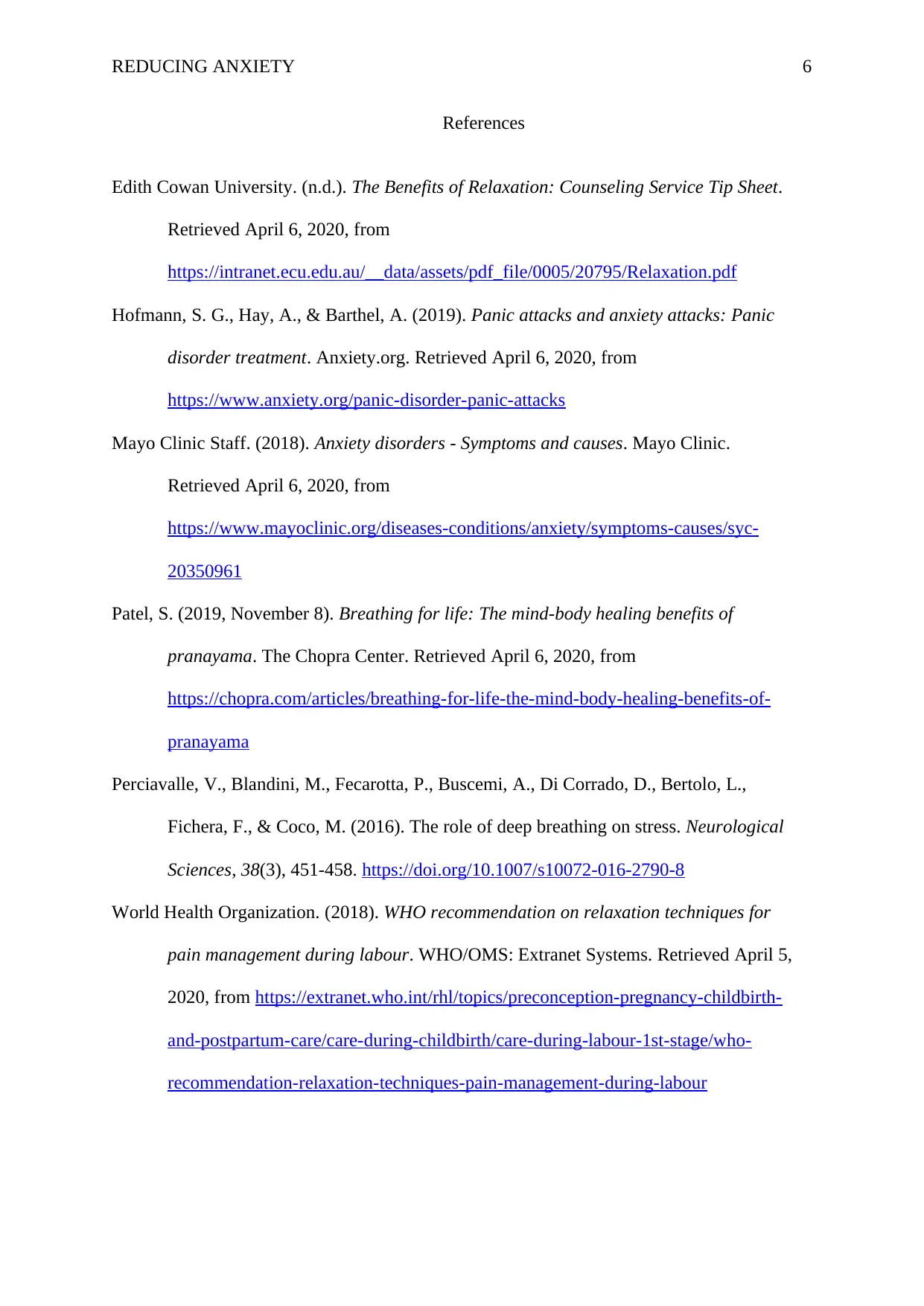
REDUCING ANXIETY 6
References
Edith Cowan University. (n.d.). The Benefits of Relaxation: Counseling Service Tip Sheet.
Retrieved April 6, 2020, from
https://intranet.ecu.edu.au/__data/assets/pdf_file/0005/20795/Relaxation.pdf
Hofmann, S. G., Hay, A., & Barthel, A. (2019). Panic attacks and anxiety attacks: Panic
disorder treatment. Anxiety.org. Retrieved April 6, 2020, from
https://www.anxiety.org/panic-disorder-panic-attacks
Mayo Clinic Staff. (2018). Anxiety disorders - Symptoms and causes. Mayo Clinic.
Retrieved April 6, 2020, from
https://www.mayoclinic.org/diseases-conditions/anxiety/symptoms-causes/syc-
20350961
Patel, S. (2019, November 8). Breathing for life: The mind-body healing benefits of
pranayama. The Chopra Center. Retrieved April 6, 2020, from
https://chopra.com/articles/breathing-for-life-the-mind-body-healing-benefits-of-
pranayama
Perciavalle, V., Blandini, M., Fecarotta, P., Buscemi, A., Di Corrado, D., Bertolo, L.,
Fichera, F., & Coco, M. (2016). The role of deep breathing on stress. Neurological
Sciences, 38(3), 451-458. https://doi.org/10.1007/s10072-016-2790-8
World Health Organization. (2018). WHO recommendation on relaxation techniques for
pain management during labour. WHO/OMS: Extranet Systems. Retrieved April 5,
2020, from https://extranet.who.int/rhl/topics/preconception-pregnancy-childbirth-
and-postpartum-care/care-during-childbirth/care-during-labour-1st-stage/who-
recommendation-relaxation-techniques-pain-management-during-labour
References
Edith Cowan University. (n.d.). The Benefits of Relaxation: Counseling Service Tip Sheet.
Retrieved April 6, 2020, from
https://intranet.ecu.edu.au/__data/assets/pdf_file/0005/20795/Relaxation.pdf
Hofmann, S. G., Hay, A., & Barthel, A. (2019). Panic attacks and anxiety attacks: Panic
disorder treatment. Anxiety.org. Retrieved April 6, 2020, from
https://www.anxiety.org/panic-disorder-panic-attacks
Mayo Clinic Staff. (2018). Anxiety disorders - Symptoms and causes. Mayo Clinic.
Retrieved April 6, 2020, from
https://www.mayoclinic.org/diseases-conditions/anxiety/symptoms-causes/syc-
20350961
Patel, S. (2019, November 8). Breathing for life: The mind-body healing benefits of
pranayama. The Chopra Center. Retrieved April 6, 2020, from
https://chopra.com/articles/breathing-for-life-the-mind-body-healing-benefits-of-
pranayama
Perciavalle, V., Blandini, M., Fecarotta, P., Buscemi, A., Di Corrado, D., Bertolo, L.,
Fichera, F., & Coco, M. (2016). The role of deep breathing on stress. Neurological
Sciences, 38(3), 451-458. https://doi.org/10.1007/s10072-016-2790-8
World Health Organization. (2018). WHO recommendation on relaxation techniques for
pain management during labour. WHO/OMS: Extranet Systems. Retrieved April 5,
2020, from https://extranet.who.int/rhl/topics/preconception-pregnancy-childbirth-
and-postpartum-care/care-during-childbirth/care-during-labour-1st-stage/who-
recommendation-relaxation-techniques-pain-management-during-labour
1 out of 6
Your All-in-One AI-Powered Toolkit for Academic Success.
+13062052269
info@desklib.com
Available 24*7 on WhatsApp / Email
![[object Object]](/_next/static/media/star-bottom.7253800d.svg)
Unlock your academic potential
© 2024 | Zucol Services PVT LTD | All rights reserved.

